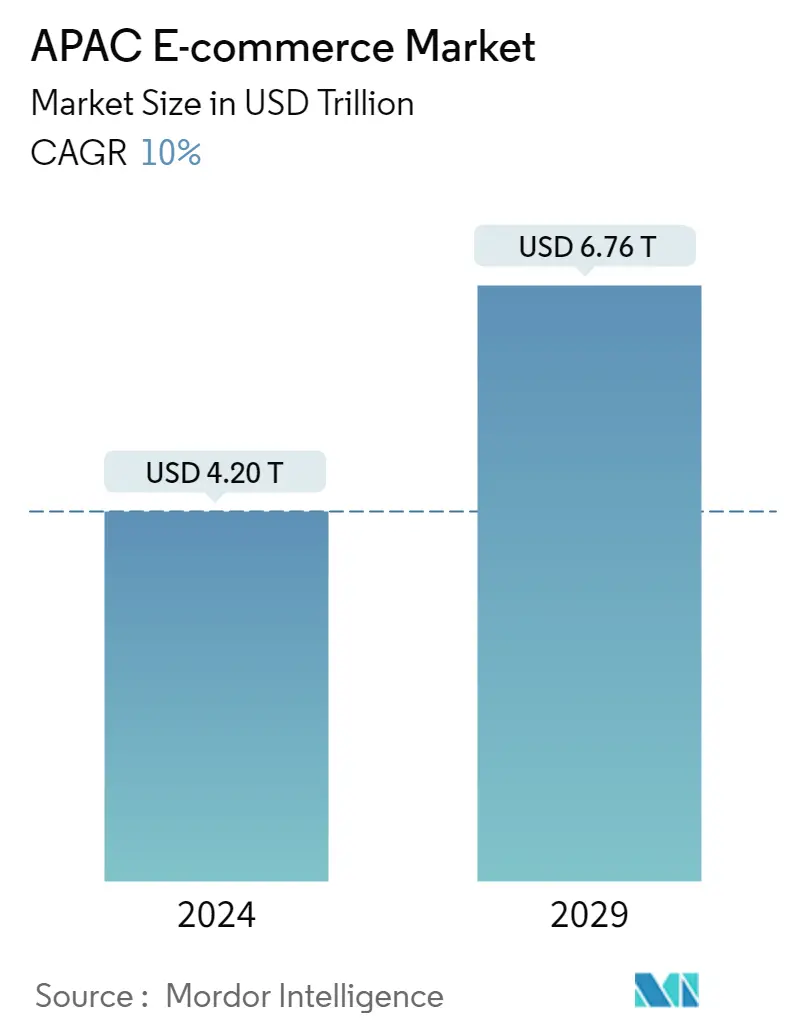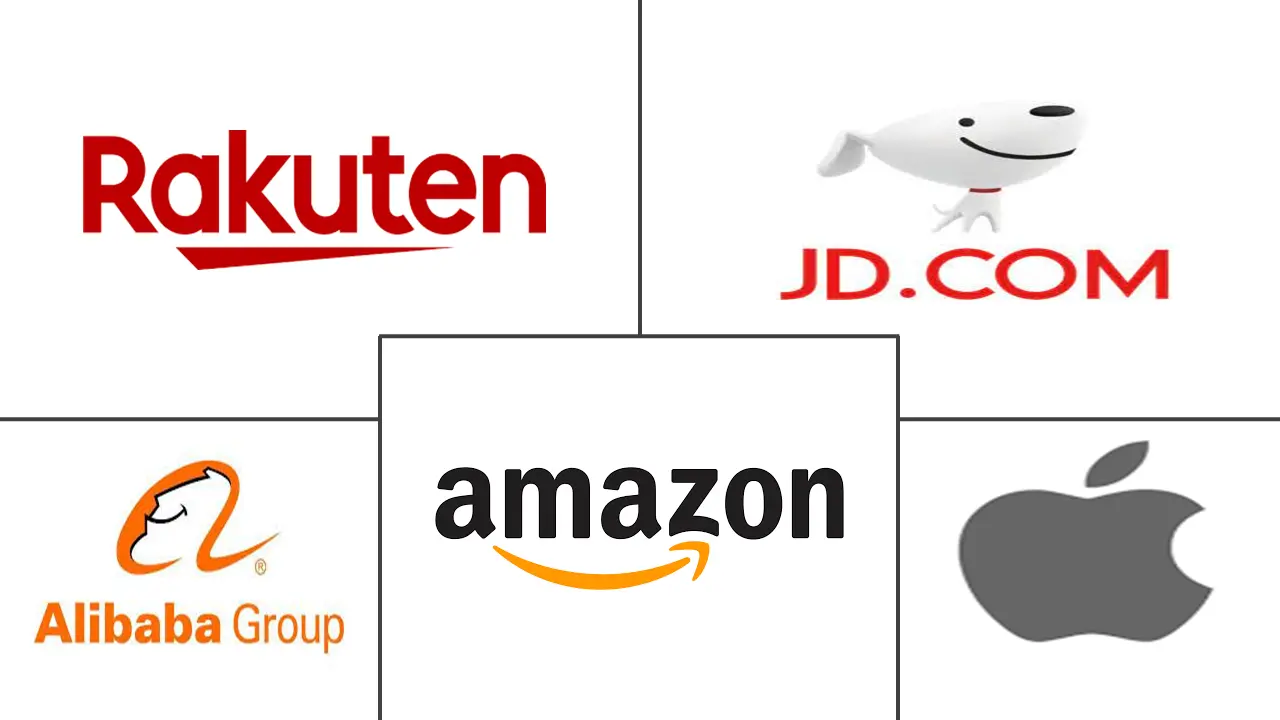Market Size of APAC E-commerce Industry

| Study Period | 2018 - 2028 |
| Base Year For Estimation | 2022 |
| Market Size (2023) | USD 3.82 Trillion |
| Market Size (2028) | USD 6.15 Trillion |
| CAGR (2023 - 2028) | 10.00 % |
| Market Concentration | Low |
Major Players
*Disclaimer: Major Players sorted in no particular order |
Need a report that reflects how COVID-19 has impacted this market and its growth?
APAC E-commerce Market Analysis
The Asia Pacific E-commerce Market size is expected to grow from USD 3.82 trillion in 2023 to USD 6.15 trillion by 2028, at a CAGR of 10% during the forecast period (2023-2028).
Consumers around the region have started to focus on online shopping due to expanding internet access and the quick, efficient, and effective distribution of goods.
- Asia has experienced a rapid increase in internet accessibility and penetration, which has sparked the region's subsequent digitization. Other industries transformed to keep up with the new, technology-driven economy worldwide, along with the area and its residents. The retail sector is one such enterprise.
- Ready-to-eat food delivery has become a significant market due to enticing, user-friendly apps, tech-enabled driver networks, and shifting consumer expectations. Food delivery services now provide a convenient and efficient way to buy food whenever and wherever customers want. The invention of online food delivery services came about due to new technological advancements and the COVID-19 outbreak, which compelled food service operators to develop innovative methods and platforms to minimize customer interaction when ordering and eating meals.
- One of the biggest trends in online retail is platform convergence. Customers prefer an all-in-one shopping experience that includes product ratings and prices, buying, and making payments using the platforms' new online payment options. Consequently, online shopping features are available on portal websites, social media, TV home shopping, over-the-top media services (OTT), etc. As a result, their platforms are becoming more popular.
- E-commerce enterprises generally store customers' bank accounts and credit card information. Email addresses, mailing addresses, usernames, and passwords are usually held by e-commerce enterprises, subjecting them to cybersecurity attacks. Cybercriminals profit from this information by duplicating credit cards and utilizing users' personal information for identity theft and fraud. Hackers may potentially hold sensitive data hostage for ransom.
- Furthermore, the supply chain of the e-commerce market was disrupted mainly due to the COVID-19 pandemic. Despite creating new opportunities for growth in terms of non-cash payments that could be realized during the forecast period, the COVID-19 pandemic slowed operations in merchant categories like restaurants, grocery stores, apparel stores, and jewelry stores, which predominantly use online payments. This further created an overall positive impact on the studied market.
APAC E-commerce Industry Segmentation
E-commerce refers to selling clothing, electronics, furniture, books, cosmetics, and other items over the Internet. Companies that provide home delivery services, such as e-commerce and m-commerce, are included in this industry.
The Asia-Pacific e-commerce market is segmented by application (beauty and personal care, consumer electronics, fashion and apparel, food and beverage, furniture, and home), by country (China, India, Japan, South Korea, and the rest of Asia-Pacific). The market sizes and forecasts are provided in terms of value (USD billion) for all the above segments.
| By B2C ecommerce | ||||||||
| Market size (GMV) for the period of 2017-2027 | ||||||||
|
| By B2B ecommerce | |
| Market size for the period of 2017-2027 |
| Geography | |
| China | |
| India | |
| Japan | |
| South Korea | |
| Rest of Asia-Pacific |
APAC E-commerce Market Size Summary
The APAC E-commerce Market is experiencing a significant growth due to the increasing internet accessibility and digitalization in the region. The online retail sector has transformed to keep up with the technology-driven economy, with ready-to-eat food delivery becoming a major market due to user-friendly apps, tech-enabled driver networks, and changing consumer expectations. The market also witnessed the trend of platform convergence, where customers prefer an all-in-one shopping experience, leading to the popularity of platforms offering product ratings, buying, and payment options. However, cybersecurity threats pose a challenge to e-commerce enterprises, as they often store sensitive customer information, making them potential targets for cybercriminals. The fashion and apparel industry is expected to witness growth in the APAC E-commerce Market, with Asia-Pacific emerging as a significant fashion market. The growing desire for individuality and personalized fashion, increased internet sales, and rising disposable incomes are factors contributing to this trend. In South Korea, the introduction of mobile commerce (m-commerce) with efficient, user-friendly apps is expected to drive growth. The APAC E-commerce Market is highly competitive, with a large number of players operating in the market. The growing popularity and adoption of e-commerce are attracting newer players to the market, increasing the competitive rivalry.
Explore MoreAPAC E-commerce Market Size - Table of Contents
-
1. MARKET INSIGHTS
-
1.1 Market Overview
-
1.2 Industry Attractiveness-Porter's Five Forces Analysis
-
1.2.1 Bargaining Power of Suppliers
-
1.2.2 Bargaining Power of Buyers/Consumers
-
1.2.3 Threat of New Entrants
-
1.2.4 Threat of Substitute Products
-
1.2.5 Intensity of Competitive Rivalry
-
-
1.3 Key market trends and share of e-commerce of total Retail sector
-
1.4 Impact of COVID-19 on the e-commerce sales
-
-
2. Market Segmentation
-
2.1 By B2C ecommerce
-
2.1.1 Market size (GMV) for the period of 2017-2027
-
2.1.2 Market Segmentation - by Application
-
2.1.2.1 Beauty & Personal Care
-
2.1.2.2 Consumer Electronics
-
2.1.2.3 Fashion & Apparel
-
2.1.2.4 Food & Beverage
-
2.1.2.5 Furniture & Home
-
2.1.2.6 Other Applications (Toys, DIY, Media, etc.)
-
-
-
2.2 By B2B ecommerce
-
2.2.1 Market size for the period of 2017-2027
-
-
2.3 Geography
-
2.3.1 China
-
2.3.2 India
-
2.3.3 Japan
-
2.3.4 South Korea
-
2.3.5 Rest of Asia-Pacific
-
-
APAC E-commerce Market Size FAQs
How big is the APAC E-commerce Market?
The APAC E-commerce Market size is expected to reach USD 3.82 trillion in 2023 and grow at a CAGR of 10% to reach USD 6.15 trillion by 2028.
What is the current APAC E-commerce Market size?
In 2023, the APAC E-commerce Market size is expected to reach USD 3.82 trillion.
